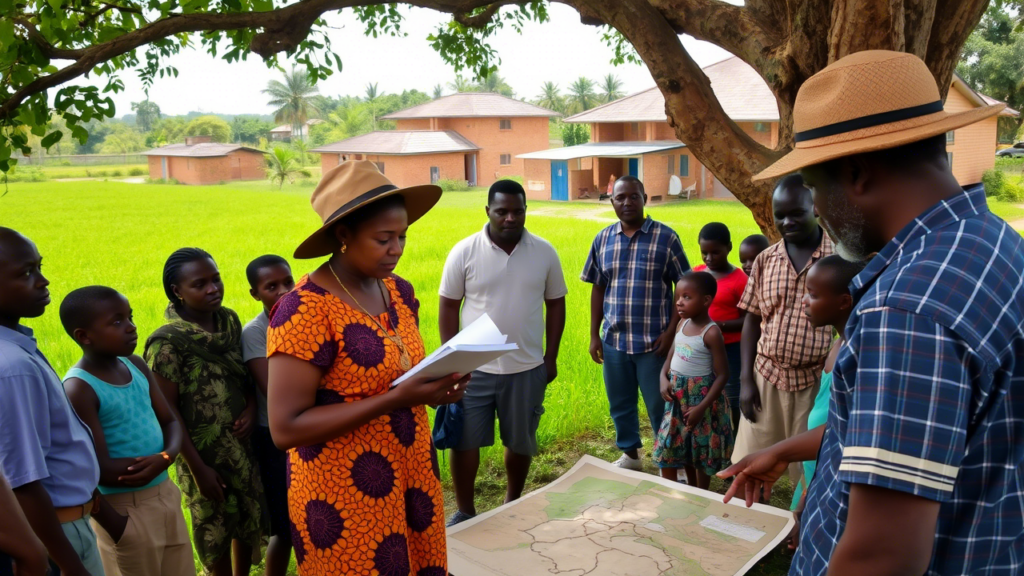Introduction
Community development in Uganda is the backbone of sustainable growth. It empowers people, improves living conditions, and builds a better future for everyone. But for community development to be effective, people need the right skills, resources, and knowledge to create long-lasting change. This is where capacity building plays a crucial role.
By strengthening the abilities of individuals, groups, and organizations, we can ensure that community development initiatives have a real impact. The goal is not just short-term fixes but long-term solutions that uplift entire communities.
In this article, we’ll explore how community development in Uganda is evolving, the importance of capacity building, and how local participation transforms lives. Whether you’re an organization looking to support local projects or an individual seeking ways to make a difference, this guide will provide valuable insights.
1. Understanding Community Development in Uganda
What is Community Development?
Community development is all about people coming together to improve their lives. It’s a process where individuals, families, and groups work on projects that address their specific needs—whether in education, healthcare, agriculture, or economic empowerment.
Why is Community Development Important in Uganda?
Uganda is a country rich in resources and potential, but many communities still face challenges like poverty, limited access to education, and inadequate healthcare. Community development ensures that people have the skills and support needed to build better livelihoods.
Key Areas Impacted by Community Development
- Education – More schools, better learning materials, and skilled teachers.
- Healthcare – Access to medical facilities, maternal health programs, and disease prevention.
- Agriculture – Training on modern farming techniques and sustainable food production.
- Economic Growth – Small business support, micro-loans, and job creation.
Without proper investment in these areas, communities struggle to grow. That’s why capacity building is a game-changer.
2. The Role of Capacity Building in Community Development
What is Capacity Building?
Capacity building means giving people the tools, knowledge, and resources they need to solve their own problems. It’s about training, mentoring, and empowering individuals and organizations to manage their own development initiatives successfully.
How Does Capacity Building Strengthen Communities?
- Skills Training – Teaching people practical skills like farming, entrepreneurship, and leadership.
- Organizational Growth – Helping local groups and NGOs become more efficient and effective.
- Sustainable Solutions – Ensuring that development projects continue even after external support ends.
When people are trained and given the right resources, they become self-sufficient, leading to sustainable community development in Uganda.
3. Enhancing Community Engagement for Sustainable Growth
Why is Community Involvement Important?
Communities thrive when people take an active role in shaping their future. Whether it’s forming local groups, joining development projects, or participating in decision-making, engagement is the foundation of long-term success.
Ways to Encourage Local Participation
- Supporting Local Leaders – Training individuals to lead and inspire their communities.
- Listening to Community Needs – Development projects should address real issues faced by locals.
- Building Trust – Organizations must work closely with communities, ensuring transparency and involvement.
Without strong community participation, development initiatives risk failure. That’s why grassroots involvement is essential.
4. Empowering Local People Through Training and Education
Why is Training Important?
If people don’t have the right skills, they can’t make the most of available opportunities. Training and education help individuals improve their livelihoods, businesses, and personal development.
Real-Life Examples of Training Success
One great example is Heifer International’s programs in Uganda, which teach farmers modern agricultural practices. This has helped thousands of families improve their income and food security.
Another powerful initiative is BRAC Uganda’s education programs, which focus on youth empowerment and vocational training.
By investing in people’s skills, we create self-reliant communities that don’t depend on external help.
5. Building Strong Local Partnerships
Why Collaboration Matters
No single organization or government can achieve community development alone. Partnerships between NGOs, businesses, and local communities are essential for real progress.
Successful Partnerships in Uganda
One effective collaboration is between local NGOs and international donors, which has resulted in improved healthcare and education services in rural areas.
By working together, we can maximize impact and create lasting change.
6. Key Services That Boost Community Development in Uganda
What Services Support Community Development?
For real progress to happen, different services must be available to help communities grow. Capacity-building programs are a key part of this. These services focus on training individuals, improving local organizations, and ensuring that development projects have a lasting impact.
How Capacity-Building Services Create Long-Lasting Impact
- Leadership Training – Teaching community leaders how to manage development projects.
- Technical Skills Development – Programs for agriculture, business, and vocational training.
- Financial Literacy Programs – Helping people manage money and start small businesses.
- Health Education – Spreading awareness about hygiene, maternal health, and disease prevention.
- Women and Youth Empowerment – Supporting marginalized groups to become economically independent.
These services help people become self-sufficient, ensuring that development is not just a one-time effort but a continuous process.
To have a deeper understanding of capacity-building in Uganda, check out this guide: Capacity Building Uganda Services.
7. Challenges Facing Community Development in Uganda
What Are the Common Challenges?
While great progress is being made, many challenges still hinder community development in Uganda. Some of the biggest obstacles include:
- Poverty – Limited access to financial resources affects development.
- Illiteracy – Many people lack basic education, making it hard to implement change.
- Lack of Infrastructure – Poor roads, healthcare facilities, and schools slow down progress.
- Limited Government Support – Some policies do not fully support community-led initiatives.
- Dependence on External Aid – While international support is helpful, long-term self-reliance is essential.
How Can These Challenges Be Overcome?
- Invest in Education – Training programs and schools should be accessible to all.
- Encourage Local Businesses – Support for small enterprises can create jobs and reduce poverty.
- Improve Infrastructure – Roads, water supply, and electricity are critical for development.
- Strengthen Policies – Governments must work with communities to create laws that promote growth.
- Promote Self-Reliance – Encourage local fundraising and income-generating activities.
Despite these challenges, community development in Uganda continues to grow, thanks to the dedication of local leaders and organizations.
8. How Local Participation Transforms Communities
The Power of Grassroots Movements
When people take charge of their own development, progress is much faster. Grassroots movements allow communities to organize themselves and push for meaningful change.
Examples of Successful Community-Led Initiatives
- Village Savings Groups – Communities create their own savings and loan programs to support small businesses.
- Community Farming Projects – Farmers pool resources to improve food production and fight hunger.
- Health Committees – Local volunteers spread awareness about hygiene, vaccination, and disease prevention.
Why Civic Engagement Matters
- Encourages Accountability – People take responsibility for their development.
- Builds Stronger Communities – Cooperation and teamwork lead to long-term success.
- Reduces Dependence on Aid – When communities are engaged, they rely less on external support.
By fostering local participation, community development in Uganda becomes more effective and sustainable.
9. The Impact of Technology on Community Development
How Digital Tools Are Changing the Landscape
Technology is playing an increasingly important role in capacity building and community development in Uganda. Digital tools make it easier to spread information, connect people, and improve education.
Examples of Technology-Driven Programs in Uganda
- Mobile Banking – Services like MTN Mobile Money allow people to save and transfer money easily.
- E-Learning Platforms – Online courses help people access education from anywhere.
- Telemedicine Services – Remote healthcare consultations improve medical access in rural areas.
Challenges of Digital Inclusion
- Limited Internet Access – Many rural areas still lack reliable connectivity.
- Cost of Technology – Smartphones and computers are expensive for low-income families.
- Digital Literacy – Not everyone has the skills to use modern technology.
To maximize the impact of technology, more investment is needed in digital education and infrastructure.
10. Strengthening Women and Youth in Community Development
Why Empowering Women and Youth is Essential
Women and young people are at the heart of community development in Uganda. However, they often face barriers like discrimination, lack of education, and financial dependency.
Programs Supporting Women and Youth
- Vocational Training – Teaching skills like tailoring, carpentry, and hairdressing.
- Microfinance Loans – Helping women and youth start small businesses.
- Leadership Workshops – Encouraging young people to take on leadership roles.
Real Success Stories
One successful initiative is the Women’s Empowerment Program by CARE Uganda, which helps women start businesses and gain financial independence. (Source)
Another inspiring program is Youth in Agriculture by FAO Uganda, which trains young farmers in modern farming techniques. (Source)
By investing in women and youth, Uganda’s future becomes more prosperous and inclusive.
11. Sustainable Development Goals (SDGs) and Community Growth
How Uganda Aligns with Global Development Goals
Uganda is actively working towards the United Nations Sustainable Development Goals (SDGs), which aim to end poverty, improve education, and protect the environment.
Examples of SDG-Focused Projects
- Clean Water Initiatives – Providing rural areas with access to safe drinking water.
- Sustainable Farming Programs – Promoting eco-friendly agricultural practices.
- Renewable Energy Projects – Expanding solar energy access in off-grid areas.
For community development to be truly sustainable, projects must align with these long-term global goals.
12. The Role of Government and Policy in Community Development in Uganda
Government Initiatives Supporting Community Growth
The Ugandan government has introduced several programs to support community development, including:
- The National Development Plan – A roadmap for economic growth and poverty reduction.
- Youth Livelihood Program – A funding initiative for young entrepreneurs.
- Women’s Empowerment Funds – Financial aid to support female-led businesses.
How Policies Impact Local Development
Good policies encourage investment in education, healthcare, and job creation, leading to stronger communities.
13. Funding Community Development in Uganda Projects
Where Does Funding Come From?
- Government Grants – Financial support from local and national governments.
- International Donors – Organizations like the World Bank and USAID fund community projects.
- Local Contributions – Community members raise money to support their own initiatives.
How to Secure Funding
- Apply for Grants – Many NGOs and government agencies offer financial aid.
- Partner with Businesses – Private companies can invest in community projects.
- Encourage Community Contributions – Small donations from locals can make a big difference.
14. Future of Community Development in Uganda
Trends Shaping the Future
- More Digital Solutions – Technology will continue to improve education and financial services.
- Greater Local Participation – Communities will take more ownership of their development.
- Sustainable Farming Innovations – Eco-friendly agriculture will become a priority.
With the right investments, community development in Uganda will continue to thrive.
Conclusion
Community development is not just about providing aid—it’s about empowering people to create their own future. Through capacity building, education, and local participation, Uganda can achieve sustainable growth.
Want to support community development? Check out Capacity Building Uganda Services to get learn more.
FAQs
What is community development in Uganda?
Community development in Uganda is a process where individuals, organizations, and government bodies work together to improve the social, economic, and environmental well-being of local communities. This includes efforts in education, healthcare, agriculture, and economic empowerment to ensure sustainable development.How does capacity building improve communities?
Capacity building provides individuals and organizations with the skills, knowledge, and resources they need to implement and sustain development projects. It enhances leadership, technical skills, financial literacy, and problem-solving abilities, ensuring long-term community transformation.What are some examples of successful community programs in Uganda?
- Heifer International Uganda – Supports farmers with training on modern agricultural techniques to boost food security.
- BRAC Uganda – Offers education and vocational training programs to empower youth and women.
- Women’s Empowerment Program by CARE Uganda – Helps women start small businesses and achieve financial independence.
How can individuals contribute to community growth?
Individuals can support community development in Uganda by:- Volunteering in local projects or NGOs.
- Donating to community-based initiatives.
- Supporting small businesses and entrepreneurs.
- Advocating for policies that promote sustainable development.
What are the main challenges facing community development in Uganda?
Some of the biggest challenges include:- Poverty – Limited access to financial resources hinders progress.
- Illiteracy – A lack of education prevents people from maximizing opportunities.
- Poor Infrastructure – Inadequate roads, healthcare facilities, and schools slow down development.
- Dependence on External Aid – While international support helps, sustainable local solutions are necessary.
- Gender Inequality – Women and youth often struggle to access the same opportunities as men.
By addressing these challenges through capacity building and local participation, Uganda can create a more self-sufficient and empowered society.






